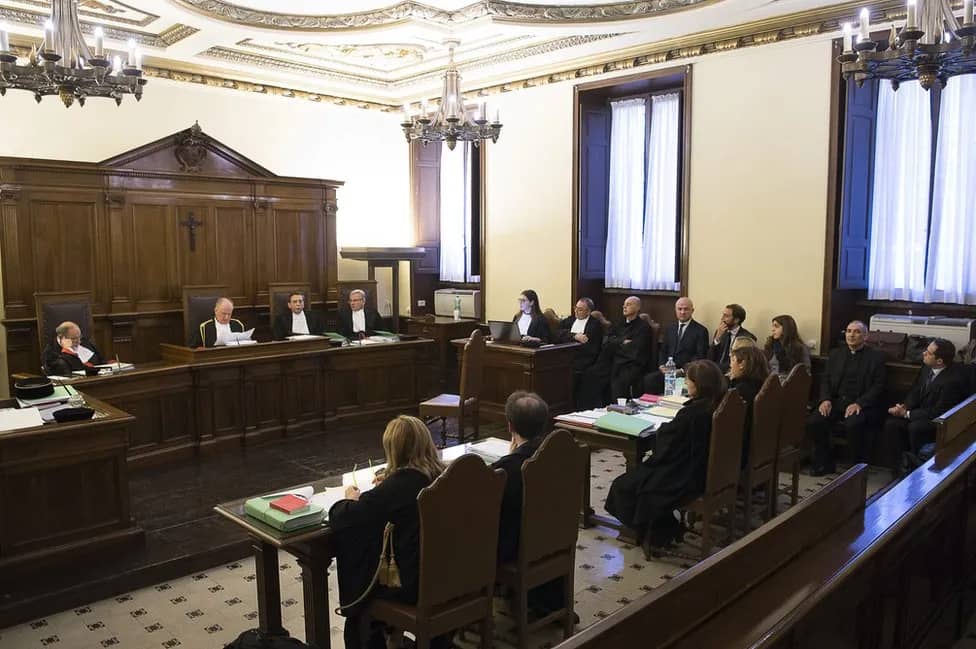It is Easter. Jesus Christ rises from the tomb: He is made manifest, the Risen Lord. He is no longer understood as simply Jesus of Nazareth. He is Lord of the living and the dead. We confess him as such.
Humanity will never be the same. By his resurrection we are brought into the way of the Lord. By his mercy, we are saved. By his resurrection we are not simply restored; rather all things are made new. The possibility for us to follow on the way of the Lord is given to us as a fruit of his resurrection. Only by his death and resurrection can we follow him.
The Easter message unfolds for us as something, which only by faith, becomes believable. And, if we dare to accept the grace of that faith, then we can see a new dynamism in our lives that never dies again.
That Easter dynamism, that call to see things new, that call to see not what is permissible but what is summoned is, in my estimation, so apparent in the apostolic exhortation, Amoris Laetitia.
I invite you for Easter week to read the exhortation. If you do, you might start smiling and say, as I did, there’s a lot new here. And you might find that newness not to be so worrisome.
Christian newness is not untethered from reality nor from its own heritage. The possibility of the extraordinarily radical newness of the resurrection comes not from thin air. When we Catholics believe in newness, we are not looking for the fanciful, the spontaneous, or the unreal. Christian newness always has history ever since the Lord rose from the tomb where Jesus of Nazareth was laid. Easter in Jerusalem had its roots in Bethlehem. There was no rupture between the two.
For Christians, newness is not a contradiction of the past; it’s born from it. The newness of Amoris brilliantly brings the tradition into the present, for the sake of the future. Our tradition must always develop, as the great theologian Marie Dominique Chenu taught; otherwise we cannot bear it into the future.
As you read Amoris, let me offer what I think is new in Amoris.
1. Amoris marks a turning point. For the past year, I have read and reviewed the reception of Amoris worldwide and the bottom line is what a group of German theologians called Amoris, in a book they edited: A “Wendpunkt,” a turning point.
They looked at the uncanny number of fresh perspectives that are integrated in Amoris: Synodal teaching, a relational theology of marriage, dictating consciences, ministerial accompaniment, mercy bearing mercy, a confessing church. Like the Germans, the Belgians called it, admiringly, “the Point of No Return.”
2. The fruit of a synodal church. Twenty-five years ago, Archbishop John Quinn suggested that we have decision-making synods, not unlike the very spirit of the Council of Jerusalem in Acts 15. At that Council, Peter, Paul and James, along with the rest of the church’s leadership, engaged robustly with the questions about how to accommodate pastorally the Gentiles in light of the then contemporary practices of the church.
Against that background, the apostolic exhortation is born out of the work of two synods where Church leaders similarly wrestled, argued, bickered, and fought about the current state of Catholic marriage and the need for a pastoral response to the lives of those who are married.
The exhortation is born out of the engagement of those two synods and Pope Francis offers his magisterial exhortation as the fruit of the synod. I expect we will see more synods and receive more from them.
3. Pace, doctrine! It’s a pastoral exhortation. One of the first synod participants to speak after the exhortation was promulgated was Cardinal Walter Kasper: “it doesn’t change anything of church doctrine or of canon law – but it changes everything.”
Kasper understands the insightful claims of Church historian John O’Malley who reminds us that the Second Vatican Council was a pastoral one, in both style and content. He also adds: “Pope Francis’s blueprint for the initiatives of his pontificate has from the very first instant been the teachings of Vatican II.”
This exhortation is, therefore, pastoral, and as O’Malley reminds us, pastoral teaching is when we are trying to get a right understanding of doctrine. That’s why we need the pastoral. That’s why we needed Vatican II. We needed to get doctrine right.
Pastoral teaching is never a poor sister to doctrine, but its companion. Through pastoral teaching, doctrine is effectively taught. Moreover, as anyone who has read the landmark historical works by the late John T. Noonan, Jr. recognizes, it is precisely through pastoral teaching that doctrine develops.
4. The marital theology is profoundly concrete and relational. Francis seems often exasperated that readers run to the eighth chapter of Amoris Laetitia without reading the first seven! Reading all of them, we find a new magisterial exhortation on marriage.
German theologian Konrad Hilpert recognizes Amoris’s relationship dynamic of marriage and sexuality as the key to this newness. He argues that the focus of its relational ethics is not on the sexual act and the set of rules that determine it, but rather on the communicative context in which a person becomes further aware of the capacity to know, understand, accept, and love another.
Here in the United States, Julie Hanlon Rubio, arguably the most prolific and significant writer on the theology of marriage, writes that the primary contribution of the exhortation is “its call to married couples to persist in married love through time. It takes up important questions—‘Why get married? Why stay married?’— and provides better answers than any other official Catholic teaching on marriage.”
5. Not surprisingly you need a primer to read it. The primers are not needed because the exhortation is complicated (it’s not), but rather it’s foundational and expansive. The theology has to be fleshed out for the local churches. This has also unleashed a market for such primers. The French published one as a “journey to take together.”
The Jesuit Institute in South Africa provided a similar one. Italian, Spanish, and German primers are all over the internet. In the United States, the National Catholic Reporter offered its own, then Julie Hanlon Rubio published a faith formation guide of it for Liturgical Press and now Tom Rausch and Roberto Dell’Oro are editing a collection for Paulist Press.
6. Moral Theology has a new task: To accompany others in the formation of their own consciences. Connor Kelly writes that with the exhortation, Francis is shifting the entire task of moral theology: Now, not only does conscience acknowledge moral truth as it is taught, but it discerns and articulates its course for the future. All Catholics must let their conscience be their guide.
Kelly directs us to paragraph 303. “Yet conscience can do more than recognize that a given situation does not correspond objectively to the overall demands of the Gospel.
It can also recognize with sincerity and honesty what for now is the most generous response which can be given to God, and come to see with a certain moral security that it is what God himself is asking amid the concrete complexity of one’s limits, while yet not fully the objective ideal.
In any event, let us recall that this discernment is dynamic; “it must remain ever open to new stages of growth and to new decisions which can enable the ideal to be more fully realized.”
The pope’s discerning competence of conscience resonates with conciliar theology, notably in Gaudium et spes. Kelly writes: “By taking this conciliar idea seriously, Amoris Laetitia significantly advances the magisterial understanding of conscience, representing another step in an ongoing process of development and reclamation of the tradition that has been active in the church since Vatican II.”
Does this mean that the Catholic conscience is now free to ignore church teaching? No. But one has to ask how much of church teaching directly dictates the regular decisions of the Catholic conscience.
The church guides us on some issues of parenting and married life, but the day to day living out of that vocation depends on the active conscientious discernment of what is best for one’s child, marriage or family. Similarly in the workplace, matters of accountability, fairness, transparency, and confidentiality prompt frequent conscientious challenges.
These multitudinous decisions made every week are not made by consulting some magisterial handbook, but rather by engaging one’s conscience regularly.
7. The habit of invoking one’s conscience is moral discernment. The pope captures the idea of following one’s conscience by talking about discernment. This emphasis on discernment was routinely recognized by readers of the exhortation; as the editors of Commonweal magazine noted, it is “a recognition of human complexity and an endorsement of subsidiarity.”
Moral theologians read the exhortation’s magisterial endorsement of this discernment as calling us to explore how as Catholics we in conscience discern what Christ is asking of us all the time. Herein lies what many refer to as the exhortation’s call not to minimalism but to the magis.
8. Accompaniment is the model of Amoris’s ministry. The pope’s voice, style, and insights are wonderfully pastoral and present in the exhortation. They are so present that when you read the exhortation you can get the uncanny feel that the pope is literally talking to you, actually following from one room of your home into another until he sits down in your kitchen and you sense he’s telling you the give and take of relationships, but he’s also listening, waiting for your replies and comments. He accompanies you as you face your own marriage and your own relationships.
Not surprisingly, accompaniment is the summons that the pope gives to his own bishops, clergy, religious and lay ministers. We are called to accompany others as they form their consciences and make daily decisions in their marriages, their families, their work places, and their communities.
9. This accompaniment engages and does not suppress the Catholic conscience. In the early part of the exhortation, Francis lets loose with one of his pastoral quips: “We have been called to form consciences, not to replace them” (AL 37). It is a sensational phrase. Google it! It’s cited again and again as a self-critical remark about the church’s teaching and preaching ministry.
The phrase appears as the pope, reflecting on how often we are not open to the workings of grace remarks: “We also find it hard to make room for the consciences of the faithful, who very often respond as best they can to the Gospel amid their limitations, and are capable of carrying out their own discernment in complex situations.”
This is a magisterial document that makes room for the Catholic conscience.
10. This ministry of accompaniment is not unlike the pastoral teachings of Pope John Paul II. I can think of any number of instructions wherein John Paul provided pastoral solutions of accompaniment to married persons. Two appear in his apostolic exhortation Familiaris Consortio (1981). First, in paragraph 34, the pope talks about the legitimate process by which a married couple who recognize the authority of Humanae vitae, but are unable to follow its teaching seek out pastoral counsel and through the law of graduality are, in certain instances, able to receive communion though they practice birth control.
The second pastoral teaching on accompaniment comes from paragraph 84. Interestingly, at the press conference where Amoris was launched, Austria’s Cardinal Christoph Schönborn was asked how to square Francis’s opening the question on confession and communion for divorced and remarried couples with John Paul II’s refusal to permit divorced and remarried Catholics to approach the Eucharist unless after penance they agreed to live in “complete continence.” (84).
With Familiaris, John Paul II allowed those divorced and remarried Catholics who lived “in complete continence” to receive communion. Before John Paul II, no pope had spoken of the possibility of divorced and remarried Catholics approaching the Eucharist.
Could not Francis, like John Paul II, allow for the engagement of other questions?
The cardinal added, “There is continuity in teaching here, but there is also something really new. There’s a real development [of doctrine], not a rupture.”
Rocco Buttiglione on the pages of the Vatican’s Osservatore Romano picked up where Schönborn left off. He asked, “Is there any contradiction between the popes who excommunicated divorced and remarried persons and Saint John Paul II who lifted that excommunication?” How is Francis any different from John Paul II? Both are reading the signs of the times and guiding the church through her own development.
11. It accompanies the consciences even of the divorced and remarried Catholics. Much is written about the issue of Francis and whether he allows or not the sacraments of reconciliation and communion, in some instances, for the divorced and remarried who in conscience seek them.
In a manner of speaking, he is suggesting (in footnote 351) that this is a question for the local churches to decide. Although some may be surprised and others may argue that local churches cannot make decisions on these issues, one of the achievements of Vatican II was to restore the integral role of the local churches within the universal church.
Francis very much seeks to implement the Council’s decisions and, as we saw earlier on synodality and on conscience, the spirit of the Council animates very much his own teachings.
Rightly Lisa Sowle Cahill noted “What Francis has done in effect is give local bishops permission and space to try innovations that are more flexible, merciful, and pastoral — but he is not mandating this.” Still, he is watching and waiting.
A few initiatives deserve mention. The bishops of Buenos Aires wrote a letter to their priests regarding how to interpret chapter eight. After acknowledging the Familiaris Consortio case of a divorced and remarried couple maintaining continence so as to receive the sacraments, the bishops add, that if that option is not viable, “a path of discernment is still possible.”
“When there is acknowledgement, in a concrete case, of the existence of limitations that diminish the degree of responsibility and culpability – particularly when a person believes they would commit another mistake that could harm any children born into the new union – Amoris Laetitia introduces the possibility of access to the sacraments of reconciliation and the Eucharist.”
They add that in some instances confidentiality might be prudent as the local community moves forward in “a spirit of understanding and openness.” The pope commented that the letter was “very good and fully captures the meaning of chapter VIII of the Amoris Laetitia. There are no other interpretations. I am sure it will do much good.”
Rouen’s Archbishop Dominique Lebrun’s All Saints Vespers’ proposed to the church of Rouen seven priests as “missionaries of Mercy” for the diocese, who have been mandated to “specially” welcome divorced people who are in a new relationship with the objective of enabling them “to examine their consciences in complete discretion in the light of the Word of God.”
Of course, other churches have been ahead of Amoris. A few days after its launch Schönborn revealed that he was “not a little proud” that the exhortation had now “fully adopted” the pastoral practice regarding remarried divorcees, which has been in use for well over 15 years in the Vienna archdiocese!
12. Restorer of mercy. My favorite admonition in the exhortation concerns mercy. In #311 Francis writes: “At times we find it hard to make room for God’s unconditional love in our pastoral activity. We put so many conditions on mercy that we empty it of its concrete meaning and real significance.
“That is the worst way of watering down the Gospel.” We have heard from all kinds of church leaders, time and again, the rebuke not to water down doctrine. But here we are warned that by conditioning God’s mercy we water down the Gospel. I have never heard that warning before. It’s a rebuke that I find refreshing.
The pope continues, “It is true, for example, that mercy does not exclude justice and truth, but first and foremost we have to say that mercy is the fullness of justice and the most radiant manifestation of God’s truth. For this reason, we should always consider inadequate any theological conception which in the end puts in doubt the omnipotence of God and, especially, his mercy.”
With these words I conclude. Restoring mercy, the fruit of Easter, the fruit of Amoris Laetitia. Read it now.

















